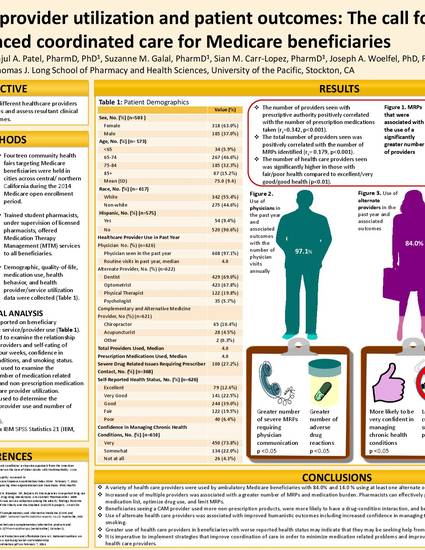
Background: The use of complementary and alternative medicine (CAM) and other non-physician health care providers (dentists, optometrists, etc.) has steadily increased in the United States; however, the associated outcomes reported in the Medicare population is limited.
Objective: To evaluate the utilization of different healthcare providers by Medicare beneficiaries and assess resultant patient outcomes.
Methods: Fourteen outreach events targeting Medicare beneficiaries were conducted throughout Northern/Central California during the 2014 open enrollment period. Trained student pharmacists (working under licensed pharmacist supervision) provided beneficiaries with comprehensive medication therapy management (MTM) services. During each intervention, demographic, quality-of-life, health behavior, and health provider/service utilization data were collected.
Results: Of 620 respondents, 525 (84%) and 84 (14%) reported using at least one non-physician healthcare professional or CAM provider, respectively. Beneficiaries who reported using non-physician healthcare providers were significantly (p<0.05) more likely to indicate being ‘very confident’ in managing their chronic health conditions. The number of providers seen with prescriptive authority was correlated with the number of prescription medications taken (rs=0.342, p<0.001). The total number of providers seen was correlated with the number of drug related issues identified (rs= 0.179, p<0.001). Beneficiaries using acupuncturists were significantly (p<0.05) less likely to report having chronic pain.
Conclusion: Many beneficiaries have multiple chronic conditions and increasingly utilize a variety of healthcare professionals. As such, bridging the communication chasm between these professionals can improve humanistic outcomes and minimize medication related issues of Medicare beneficiaries. Coordinated care, a key strategy for improving healthcare delivery under the Affordable Care Act, is a step in the right direction.
Available at: http://works.bepress.com/joseph-woelfel/25/
